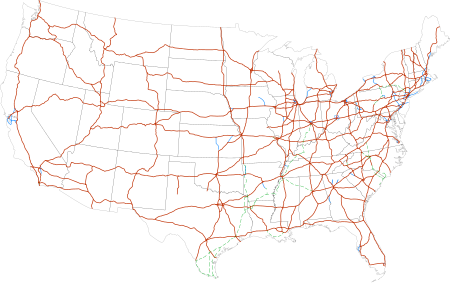
Back Liste der Interstate Highways German List of Interstate Highways English Listo de Insterŝtataj Ŝoseoj Esperanto Anexo:Autopistas Interestatales Primarias Spanish Interstate Highway System'i kiirteede loend Estonian Zerrenda:Ameriketako Estatu Batuetako estatuarteko autobideak Basque Liste des interstates French 州間高速道路一覧 Japanese Lijst van interstate highways in de Verenigde Staten Dutch Lista de autoestradas interestaduais dos Estados Unidos Portuguese


Primary Interstate Highways are the major interstate highways of the United States and have a one or two-digit route number. Even (0, 2, 4, 6, or 8) route numbers are given to east/west routes, with the smaller numbered routes in the south (I-10) and bigger numbered routes in the north (I-90). Similarly, odd (1, 3, 5, 7, or 9) route numbers are given to north/south routes, with the smaller numbered routes in the west (I-5) and the bigger numbered routes in the east (I-95). Routes that end in a 0 or a 5 are major routes in the system. These Interstates generally go from coast to coast or from the bottom to the top of the U.S. For example, Interstate 5 goes from the Mexican Border at San Diego, California to the Canadian Border at Blaine, Washington. Likewise, Interstate 10, the southernmost cross-country Interstate Highway, goes from Santa Monica, California on the west coast to Jacksonville, Florida on the east coast. The longest Interstate Highway in the United States is Interstate 90.
There are five sets of numbers that are used more than once throughout the system; the highways whose numbers are used more than once are separated by big distances to avoid confusion. Below, these are made separate from each other by West and East.
Three-digit Interstates are spur or loop Interstates that usually are in big cities and areas outside of cities. The last two digits of a three-digit Interstate are always the number of the route it is related to. If the first digit is odd (1, 3, 5, 7, or 9), the Interstate is usually a spur route while if the first digit is even (2, 4, 6, 8, or 0), the Interstate is usually a loop route.